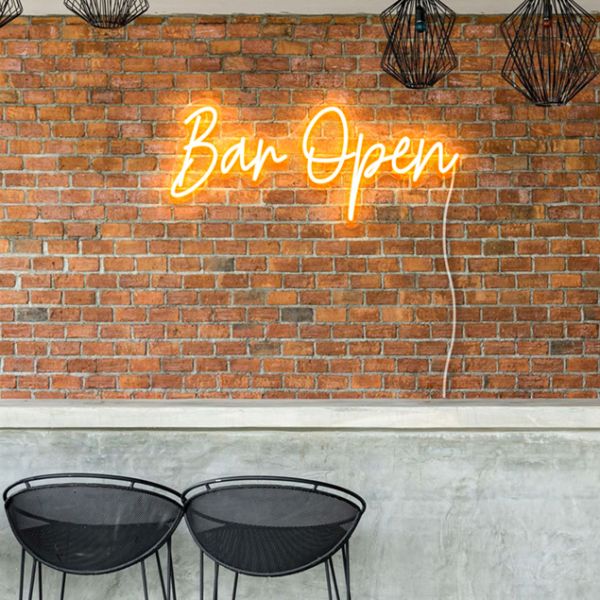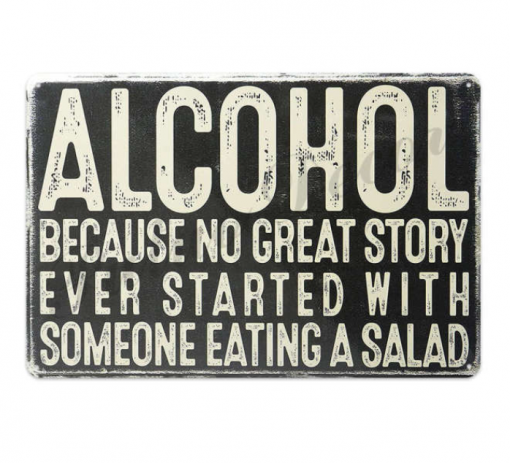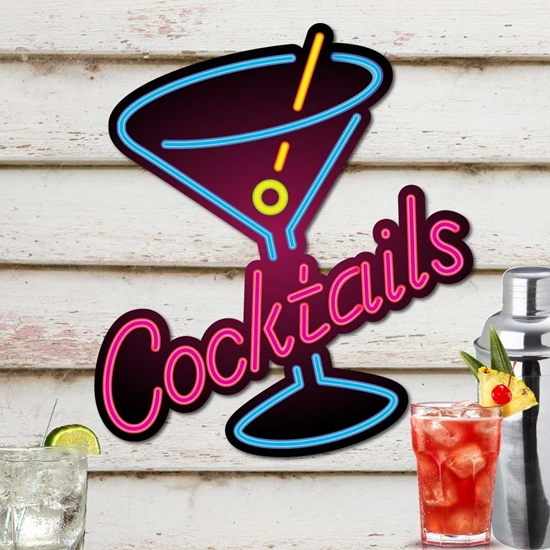Bar signs differ greatly in terms of the material used they are made of, each having distinct advantages and characteristics that suit various designs and purposes. Here is an overview of the most popular material used in bar signs and what distinguishes them. Wood
Characteristics: Natural, rustic, warm.
Durability Material generally lasts, but may be affected by humidity or need maintenance.
Uses: Perfect for bars with rustic or vintage themes customized name signs and menu boards.
Customization: Can also be painted or stained. It is easily customizable and comes in a variety of colors.
2. Metal
Characteristics: Sleek, modern, industrial.
Durability - Extremely durable and weather resistant and suitable for indoor as well as outdoor use.
Uses : Excellent for modern or Industrial-themed bars and other signs that are durable.
Customizations: They may be embossed, painted or laser-cut. These are usually used for intricate logos.
3. Neon
Characteristics: Bright, eye-catching, retro.
The durability of a product is an issue. It's not always durable If it's taken care of well, it will last for many years.
Uses: Excellent for retro and branding signs.
Customization is not possible due to the nature, and limitations of neon tubing. Available in different colors.
4. Find out more about Acrylic
Characteristics: Versatile, lightweight, modern.
Durability: Resistant to fade and tough, perfect for indoor usage.
Examples include: Modern elegant signs that are sleek and stylish, with illuminated letters, detailed logos, and modern signs.
Customization: Can be laser-cut or printed. It can also be layering to create a 3D effect. Available in various colours and textures.
5. Vinyl
Characteristics: Easy to use, adaptable, and adaptable.
Durability: Can be used in temporary or semi-permanent applications. If vinyls of high quality are used they will last for a long time outdoors.
Uses: Ideal to use for window graphics, promotions that are temporary and decals that are custom-designed.
Customization: Choose from a wide range of colors, designs and shapes. Easy to remove and apply.
6. Chalkboard
Characteristics: Functional, rustic, interactive.
Durability - Regular maintenance is required (cleaning and replacing chalk). If the chalk is not maintained properly the chalk could be damaged.
Uses: Great for menu boards and interactive signs that are frequently updated, such as daily specials.
Customization: Handwritten notes or designs are possible. The artwork can be framed in a variety of materials to increase quality and appeal.
7. Glass
Characteristics: Elegant, sleek, modern.
Durability - Fragile, however it is able to become tough when tempered. Backlighting is commonly utilized to improve the look.
Uses: Can be used to illuminated signs, or window signs.
Customizations: They may be printed, painted or scratched. It is used often in conjunction lighting for an eye-catching result.
8. PVC (Polyvinyl Chloride)
Characteristics: Lightweight, versatile, cost-effective.
Durability - Weather resistant and suitable for both indoors and outdoors.
Applications: Typically, it is used for temporary signage, event promotions and signs for branding that are lightweight.
Customization: It is painted, printed, or cut into different designs. Available in a variety of sizes.
9. LED lighting is an excellent alternative to bulbs that are traditional.
Characteristics: Energy-efficient, bright, modern.
Durability - Very robust and durable. Perfect for use over the course of time.
Uses : Great for illuminating signs or creating dynamic lighting effects, and for modern branding.
Customization: Available in a variety of colors. It can also be programmed to allow changing messages or animations.
10. Foam Board
Its characteristics include being lightweight, low-cost and simple to use.
Durability: less durable and appropriate for indoor use only.
Applications: Ideal for temporary promotions or events as well as informational signs.
Customization is possible by printing or applying vinyl. It is simple to cut the material into many different shapes.
Each material offers distinct characteristics to bar signs, influencing their appearance, durability, and suitability for different applications and environments. The right material to use is determined by the purpose for which it was designed as well as aesthetic and budgetary constraints. Check out the top get the facts on hanging bar sign for website tips including pub signs for home bars, personalised outdoor pub signs, garden bar sign personalised, personalised home bar signs, personalised home bar signs, home bar pub signs, personalised metal pub signs, pub signs for home bars, pub signs made, indoor bar signs and more.

How Do Bar Signs Differ In Terms Of Readability?
The size and readability of bar signs is influenced by a variety of factors such as font choice as well as color contrast, the location and lighting. These elements can impact the readability and effectiveness of signs for bars. Font Choice
The Sign's Characteristics The Sign is a Typeface.
Readable Fonts - Simple fonts that have serifs that are not serifs, such as Arial or Helvetica. Clean serif fonts like Times New Roman.
Styled fonts: Fonts that have graphic or scripted designs may be difficult to be read from a distance or in low light.
Impact: Clear and legible fonts allow information to be quickly and easily comprehended by patrons.
2. Font Size
Characteristics include the font size on the sign.
Large Fonts - Ideal for exteriors and signs.
Small fonts can be utilized for small signs, menus and even tabletop signage.
Impact: For reading from various distances, it is essential to choose the correct font size. A text that is larger is simpler for readers to comprehend.
3. Color Contrast
Characteristics: The differences in color between the text and the background.
High contrast: Dark text or text that has a light background.
Low Contrast: Text and background colors that are similar can cause difficulty in reading the text (e.g. grey and black).
Effect: A high contrast enhances readability and makes sure that the text stands out clearly.
4. Lighting
The sign's characteristics include how the sign is lit.
Well-lit signs: Signs which have front or back lighting increase visibility in low-light conditions.
Poorly Lit Signs Signs without sufficient lighting can be difficult at night to read in dimly lit areas.
Impact: Proper illumination ensures signs are always easily read and clearly visible in dim lighting conditions.
5. Material and Finish
Signs can be distinguished by the kind of material used as well as the final appearance.
Matte Finish Matte Finish: Reduces reflections and glare and makes text easier read.
Glossy Finish: May cause reflection, particularly under direct light, which could make it difficult to read.
Impact: The correct material and finish enhance visibility by minimizing glare and reflections.
6. Text Layout
Characteristics The arrangement of the text on the sign.
Clear Hierarchy. Information can be organized using subtitles, headings and body text.
Signs with a messy layouts are difficult to comprehend.
Impact An organized, clear layout makes it easy for patrons to locate and understand the content.
7. Distance from the camera
Specifications: The distance from which the sign is meant to be read.
Larger fonts and high contrast fonts are essential to read long distances.
Short Text: Shorter text sizes are fine, but clarity and simplicty remain important.
The impact of signs is created using the intended reading distance in your mind.
8. Placement
The most obvious sign of this is the placement of a bar sign within the bar.
Positioning at eye level in areas that are well lit, without obstructions.
Poor Positioning - High, behind objects or in dark areas.
Impact: The location of signs makes them easily readable by the patrons.
Signs that are simple to comprehend
Exterior Signage
Characteristics include: Large, high-contrast text which is well lit (e.g. neon or backlit), and placed prominently.
Impact: The sign is easy to read and catches the eye from afar, bringing in more customers.
Menu Boards
Characteristics are: Large text, clear headings for items and chalkboards that are backlit with adequate lighting.
Impact: It is easier for customers to decide and understand their orders. They will have an easier experience.
Directional signs
Specifications: Clear and large text with simple and clear arrows. A high contrast. Strategically placed at eye-level.
Impact Enhances efficiency and overall satisfaction of patrons by helping them navigate through the area.
Promo Signs
Signage characteristics: High contrast and bold text, well-lit and positioned in areas that have high traffic.
Impact: Effectively communicates special offers and occasions to customers, thereby encouraging their participation.
Factors Affecting Readability
Environment: Ambient lighting and the bar's overall atmosphere can affect how well signs are read. Readability is enhanced in environments which are bright and well-lit.
Patron Movement: In crowded bars, signage must be easily readable by patrons moving around. It is essential to use large, high-contrast signs in such situations.
It is crucial to keep up-to-date signs regularly, especially when they are frequently changed or are subject to daily changes, such as specials.
By focusing their attention on these elements bar owners can make sure they have signage that is not just visually appealing but also legible, improving the overall experience for customers. Have a look at the best cocktail bar sign for more examples including pub signs for garden bar, personalised garden bar signs, make your own bar sign, personalised home pub sign, personalised signs for bar, home made bar sign, modern pub sign, outdoor personalised bar sign, gin bar sign, signs for the bar and more.

How Do Bar Signs Differ In Terms Of Branding?
Bar signs are important for branding, as they communicate the character the style, appearance and personality of a business to customers. Here are several bar signs that are different from each other in terms branding. Logos and brand identity
Logo Integration - Integrating the logos of bars prominently on signage creates brand recognition, and strengthens the identity of an establishment.
Consistent Branding - Signs need to be synchronized with other branding elements, like coasters or menus, as well as social media profiles, in order to keep the same uniformity.
2. Design and Visual Style
Thematic Design Signs: Represent the overall theme and atmosphere of the establishment, whether it's a cozy bar, sleek lounge, or a lively nightclub.
Custom Graphics - Unique graphics, typography and images help to distinguish brands and draw patrons' attention.
3. Color Scheme
Branded Colors. Utilizing a bar's brand colors on its signage will assist in strengthening the brand and establish a consistent identity.
Readability, contrast, and legibility: Colors can be chosen to not only assure brand consistency, but and also to ensure readability under different lighting conditions.
4. The tone of the message
Brand voice: Signs can convey a bar's personality or tone, be it playful and playful elegant and sophisticated or edgy.
Slogans and Taglines. Taglines that are catchy, or slogans, can enhance the brand's message and leave a lasting impression with customers.
5. Placement and Visibility
Signage location: Signs are placed strategically to increase their visibility either at the entry point, in the bar, or the entire venue.
Size and Scale - Signs that are larger are more powerful and command the attention of. Smaller signs can give subtle branding to smaller areas.
6. Specialty Signage
Signage: Customized signage like neon signs, chalkboard menus can add to the appeal of a bar and reinforce its brand image.
Interactive Elements: Signs that incorporate interactive elements like QR codes or digital menus, enhance the experience for patrons while increasing brand awareness.
7. Brand Storytelling
The signage should provide information about the bar’s history as well as its location or even the founder’s story. This will create an emotional connection between patrons and the bar.
Unique Selling Points Highlighting distinctive products, signature cocktails and other features in the signage will help to enhance the brand's value. It also helps to attract customers to patronize your establishment.
8. Promotional and seasonal branding
The Holiday Season: Decor and themed signage convey the spirit of Christmas in the bar and help make it memorable for customers.
Signs for Promotion: Signs advertising events or happy hours can boost sales and increase brand awareness.
9. Customer Engagement
Users-generated content: Encourage patrons to post photos of signs on social media platforms. This can increase the brand's visibility and help create a sense of community at the bar.
Interactive Signage. Signs inviting patron participation (such as photo booths, chalkboard walls or even photo boards) provide a memorable experience and strengthen the loyalty of your brand.
10. Digital Branding
Digital Signage. Interactive displays or LED screens are a great way to create dynamic branding providing real-time updates to content, animations and multimedia.
Online presence - QR codes or handles for social media are placed on signage to drive online interaction. They help patrons connect with a bar's presence and make it easier to access.
With the use of signs to promote their business Bar owners can use signage to effectively communicate their brand's message, connect with their customers, and differentiate their establishment from a highly competitive market. View the best more hints on bar sign outdoor for blog examples including large personalised bar signs, personalised signs for bar, to the bar sign, personalised sign for bar, large personalised bar signs, pub bar signs for sale, bar signs, bar sign hanging, personalised signs for home bar, outdoor home bar signs and more.
